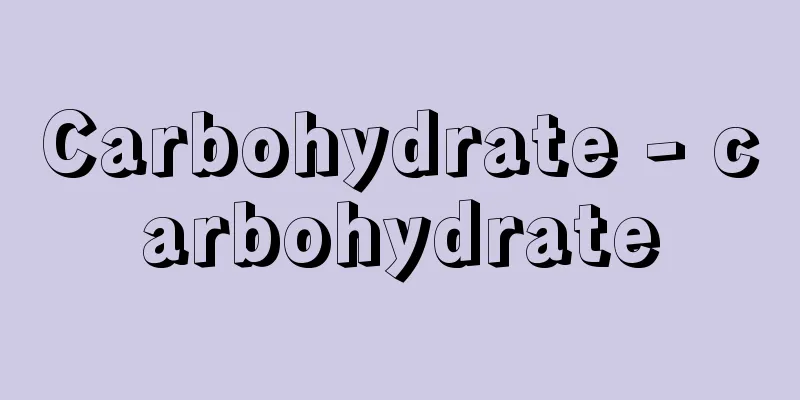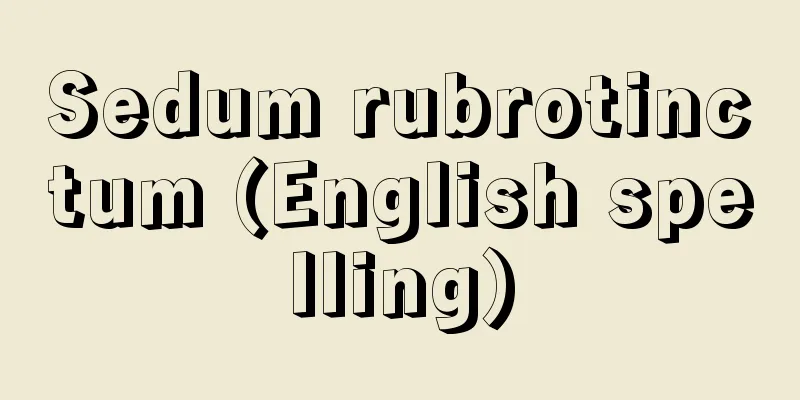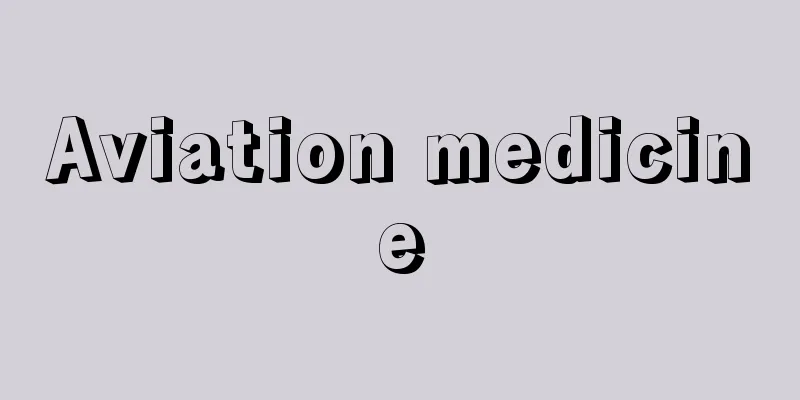Carbohydrate - carbohydrate

|
The most abundant organic compound on Earth, also known as sugars or carbohydrates in a broad sense, is an extremely important substance for living organisms. Generally, it is composed of the three elements carbon, hydrogen, and oxygen, and many of them can be written as the general formula Cm ( H2O ) n , and are called carbohydrates because they look as if they are composed of carbon and water molecules ( H2O ). Carbohydrates also include those with one fewer oxygen atom than the general formula (deoxyribose, etc.), those containing sulfur compounds (chondroitin sulfate, etc.), and those containing nitrogen atoms (amino sugars, etc.). Chemically, it is a general term for polyhydric alcohol aldehydes or ketones and their derivatives. [Ryota Uehara and Issei Mabuchi] Classification and typesCarbohydrates are classified into monosaccharides, oligosaccharides (small sugars), and polysaccharides depending on the number of sugar units that make up the carbohydrate. (1) Monosaccharides There are aldehyde and ketone types, called aldoses (e.g. glucose) and ketoses (e.g. fructose), respectively. They have reducing properties because they have an aldehyde group or an α (alpha)-ketol group, and the detection of reducing properties using Fehling's solution has long been known. In terms of stereochemistry, they also have optical rotation due to the presence of asymmetric carbons, and each type has two optical isomers. Monosaccharides are further classified according to the number of carbons in one molecule, from trioses to heptoses. Glucose is a hexose. (2) Oligosaccharides: Several monosaccharide units are linked by glycosidic bonds (the same as ether bonds in sugars), and those with two linked units are called disaccharides, including sucrose, maltose, and lactose. They are further classified as trisaccharides, tetrasaccharides, etc. Among oligosaccharides, those in which the aldehyde group is not used in the bond and is in a free state have reducing properties, but sucrose, the most well-known disaccharide, has no reducing groups. Both monosaccharides and oligosaccharides are easily soluble in water, but not in ether. All have a sweet taste, and fructose in particular has a strong sweet taste. (3) Polysaccharides are made up of many monosaccharide units linked together by glycosidic bonds, with molecular weights ranging from a few thousand to over a million. Hydrolysis produces oligosaccharides or monosaccharides. A polysaccharide made up of a single monosaccharide is called a simple polysaccharide, while a polysaccharide made up of multiple types of monosaccharides is called a complex polysaccharide. [Ryota Uehara and Issei Mabuchi] Carbohydrates and biologyCarbohydrates are widely distributed throughout the living world, and their biological functions can be broadly divided into (1) being components of living organisms and (2) serving as a source of energy for activity. Polysaccharides that maintain structure are also called structural polysaccharides, and include cellulose, which makes up the cell walls of plants, chitin, which makes up the exoskeleton of insects and crustaceans, chondroitin sulfate, which is a component of animal cartilage and tendons, and hyaluronic acid, which is found in synovial fluid and vitreous fluid. Carbohydrates, along with lipids and proteins, play an important role as an energy source in living organisms. Green plants synthesize glucose from water and carbon dioxide in the air through carbon dioxide assimilation, and store it as starch. Since animals cannot synthesize carbohydrates themselves, they ingest them from plants and store them in the liver as glycogen. Polysaccharides stored in living organisms as an energy source are also called nutritive polysaccharides (storage polysaccharides). These nutritive polysaccharides are metabolized by glycolysis and the TCA cycle in animals and plants, and by fermentation in yeast and other organisms, and are useful as energy sources and for biosynthesis in vital activities. From a nutritional perspective, starch and glucose are particularly important. Humans ingest most of the energy they need as starch, because most other polysaccharides cannot be used as nutrients. Glucose also plays an important role in animals as blood sugar, serving as an energy source throughout the body, especially in the brain, central nervous system, and muscles. Incidentally, many compounds consisting of sugar residues and non-sugar residues are also important for living organisms. Complex carbohydrates, in which oligosaccharides or polysaccharides are covalently bonded to lipids or proteins, are involved in structural support and have been shown to function as specific markers and signals on the cell surface in various cell-cell interactions and biological recognition processes. [Ryota Uehara and Issei Mabuchi] "Carbohydrates: Chemistry for the Life Sciences" by Nishizawa Kazutoshi and Yoshimura Toshiji (1980, Asakura Publishing)" ▽ "New Nutritional Chemistry" by Naito Hiroshi et al. (1987, Asakura Publishing)" ▽ "Biochemistry" by Eric E. Corn et al., translated by Tamiya Nobuo and Yagi Tatsuhiko (1988, Tokyo Kagaku Dojin)" ▽ "Organic Chemistry for the Life Sciences" by Gardner W. Stacy et al., translated by Goto Ryozo and Sera Akira (1990, Tokyo Kagaku Dojin)" ▽ "Illustrated Modern Biology" by Niitsu Tsuneyoshi et al. (1994, Maruzen)" ▽ "Biochemistry 1: Biological Components, Biochemistry 3: Metabolism and Biosynthesis" by Philip W. Kuchel et al., translated by Hayashi Toshihiko (1996, Ohmsha)" ▽ "Biochemistry for Beginners: The Why of Life" by Hirasawa Eiji "Basic knowledge to understand the relationship between sugar and health" (1998, Kagaku Dojin) " ▽ "Health Science Series 8: Sugar and Health" edited by the East Japan Branch of the Japanese Society for Applied Glycoscience, edited by Hidaka Hidemasa and Sakano Yoshiyuki (1998, Kansai Society Center)" ▽ "All About Food Science" by P.M. Gaiman et al., edited by Nakahama Nobuko, translated by Murayama Atsuko and Shinagawa Hiroko (1998, Kenpakusha)" ▽ "Semester-specific Introduction to Biology" by Nagai Akira and Ueno Shinpei (1998, Tokai University Press)" ▽ "Nutrition Handbook" by Ishii Yuko (1998, Hoikusha)" ▽ "Nutrition and Exercise - Q&A on the Life Science of Physical Exercise, Nutrition and Health" edited by Fushiki Toru et al. (1999, Kyorin Shoin)" ▽ "Ann C. "The Latest Knowledge on Exercise and Diet: Strategies for Disease Prevention and Health Promotion" by Snyder, supervised translation by Gen Yamazaki, translated by Yuko Oguma et al. (1999, Knapp)" ▽ "Biochemistry" by Rothkoski, supervised translation by Yotaro Tajima, translated by Toyoaki Akino et al. (1999, Nishimura Shoten)" ▽ "Ritter's Biochemistry" by Ritter, translated by Kazuo Sudo et al. (1999, Tokyo Kagaku Dojin) ▽ "Borchardt-Shor's Modern Organic Chemistry, Vol. 2, supervised translation by Kenji Furukawa et al. (2000, Kagaku Dojin)" ▽ "Food and Nutrition Science Series: Introduction to Nutrition" by Shozaburo Kitaoka, 3rd edition (2000, Baifukan)" ▽ "Nutrition - A Biochemical Approach" edited by Tsutomu Yoshida, 2nd edition (2000, Gakubunsha)" ▽ "Diet and Exercise: Thinking about Food for the 21st Century," edited by the Nestle Chemical Promotion Association and edited by Akiyoshi Wada et al. (2000, Kansai Academic Society Center)" ▽ "Easy-to-understand Nutrition," edited by Tsutomu Yoshida and written by Junko Ito et al. (2001, Sankyo Publishing)" ▽ "New Edition: Food Chemistry Experiments," edited by Shunjiro Hashimoto et al. and edited by Kodansha Scientific (2001, Kodansha)" ▽ "Now You Can Become a Registered Dietitian 5: Food Science, Food Processing, and Cooking," edited by the 21st Dietitian National Examination Committee (2001, Kodansha)" ▽ "Carbohydrates: The Source of Heat and Energy," edited by Domu (2002, Kaiseisha) " ▽ "Woolett's Organic Chemistry," written by R. J. Woolett and translated by Tomoyoshi Takahashi et al. (2002, Kagaku Dojin) " ▽ "Basic Nutrition," edited by Tsutomu Yoshida (2003, Ishiyaku Publishing)" ▽ "Biochemistry from the Basics" edited by Tsutomu Yoshida, Yasushi Fujimori et al. (2003, Gakubunsha)" ▽ "Basic Chemistry for Food Nutrition" edited by Masatake Toyoda and Makoto Tajima (2003, Maruzen)" ▽ "Biochemistry" edited by Osamu Igarashi and Fumio Shimura (2003, Koseikan) [References] | | | | | | | | | | | | | | | | | | | | | | | | | | | | | | | | | | | | | | | | | |Source: Shogakukan Encyclopedia Nipponica About Encyclopedia Nipponica Information | Legend |
|
地球上でもっとも多量に存在する有機化合物で、広義には糖類あるいは糖質ともいい、生物にとってきわめて重要な物質である。一般に炭素、水素、酸素の3種の元素からなり、一般式Cm(H2O)nとして書き表せるものが多く、あたかも炭素と水の分子(H2O)からなっているようにみえるので炭水化物とよばれる。なお、酸素原子の数が一般式より一つ少ないもの(デオキシリボースなど)、また硫黄(いおう)化合物を含むもの(コンドロイチン硫酸など)や窒素原子を含むもの(アミノ糖など)も炭水化物のなかに含める。化学的には、多価アルコールのアルデヒドまたはケトンおよびその誘導体の総称である。 [上原亮太・馬渕一誠] 分類および種類炭水化物はそれを構成する単位糖の数により、単糖、オリゴ糖(少糖)、多糖に分類される。 (1)単糖 アルデヒド型のものとケトン型のものがあり、それぞれアルドース(ブドウ糖など)およびケトース(果糖など)とよぶ。アルデヒド基またはα(アルファ)-ケトール基をもつため還元性があり、フェーリング液を用いた還元性の検出は古くからよく知られている。また立体化学的には、不斉炭素をもつため旋光性があり、それぞれに2種の光学異性体が存在する。単糖類は、1分子のもつ炭素の数により、さらに三炭糖から七炭糖まで分類される。ブドウ糖は六炭糖である。 (2)オリゴ糖 単糖単位が数個、グリコシド結合(糖類でのエーテル結合をいう)したもので、2個結合したものをとくに二糖類といい、ショ糖、麦芽糖、乳糖などが含まれる。さらに、三糖類、四糖類などと分類される。オリゴ糖でもアルデヒド基が結合に使われずに遊離の状態にあるものは還元性をもつが、もっともよく知られた二糖類であるショ糖は還元基をもたない。単糖およびオリゴ糖はともに水に溶けやすく、エーテルには溶けない。いずれも甘味をもち、とくに果糖は強い。 (3)多糖 単糖単位が多数グリコシド結合してつながったもので、分子量は数千から100万を超えるものもある。加水分解することにより、オリゴ糖あるいは単糖を生じる。単一の単糖類から構成されるものを単一多糖といい、複数種の単糖類から構成されるものを複合多糖という。 [上原亮太・馬渕一誠] 炭水化物と生物炭水化物は生物界に広く分布するが、その生物的機能は大きく分けて(1)生物体の構成成分であることと、(2)活動のエネルギー源となることである。 構造を保つ多糖類は構造多糖ともよばれ、植物の細胞壁をつくるセルロース、昆虫や甲殻類などの外皮をつくるキチン、動物の軟骨や腱(けん)の成分であるコンドロイチン硫酸、関節液や眼球硝子(しょうし)体液に含まれるヒアルロン酸などがある。 エネルギー源としての炭水化物は、脂質やタンパク質とともに生物体において重要な役割を果たしている。緑色植物は炭酸同化作用によって水と空気中の炭酸ガス(二酸化炭素)からブドウ糖を合成し、これをデンプンとして貯蔵する。動物は自ら炭水化物を合成できないので、これを植物から摂取し、グリコーゲンとして肝臓に貯蔵する。エネルギー源として生物体に蓄えられた多糖は栄養多糖(貯蔵多糖)ともよばれる。これらの栄養多糖は、動植物においては解糖系やTCA回路、また酵母などでは発酵によって代謝され、生命活動のエネルギー源や生合成に役だっている。 なお、栄養学的にはとくにデンプンとブドウ糖が重要である。ヒトは必要とするエネルギーの大半をデンプンとして摂取するが、これはほかのほとんどの多糖類を栄養とすることができないからである。また、ブドウ糖は、動物においては血糖として全身の、とくに脳、中枢神経系、筋肉におけるエネルギー源として重要な役割を果たしている。ちなみに、糖残基と非糖残基からなる化合物にも、生物体にとって重要なものが多い。オリゴ糖や多糖が脂質やタンパク質などと共有結合した複合糖質は、構造支持にかかわるほか、種々の細胞間相互作用や生物的認識の過程で細胞表面の特異的マーカーやシグナルとして機能することが明らかになっている。 [上原亮太・馬渕一誠] 『西沢一俊・吉村寿次著『炭水化物――ライフサイエンスのための化学』(1980・朝倉書店)』▽『内藤博ほか著『新 栄養化学』(1987・朝倉書店)』▽『Eric E. Cornほか著、田宮信雄・八木達彦訳『生化学』(1988・東京化学同人)』▽『Gardner W. Stacyほか著、後藤良造・世良明訳『生命科学のための有機化学』(1990・東京化学同人)』▽『新津恒良ほか著『図説 現代生物学』(1994・丸善)』▽『Philip W. Kuchelほか著、林利彦訳『生化学1 生体構成物質』『生化学3 代謝と生合成』(1996・オーム社)』▽『平沢栄次著『はじめての生化学――生活のなぜ?を知るための基礎知識』(1998・化学同人)』▽『日本応用糖質科学会東日本支部監修、日高秀昌・坂野好幸編『健康の科学シリーズ8 糖と健康』(1998・学会センター関西)』▽『P・M・ゲイマンほか著、中浜信子監修、村山篤子・品川弘子訳『食物科学のすべて』(1998・建帛社)』▽『永井彰・上野信平著『セメスター対応 生物学入門』(1998・東海大学出版会)』▽『石井裕子著『栄養ハンドブック』(1998・保育社)』▽『伏木亨ほか編『栄養と運動――身体運動・栄養・健康の生命科学Q&A』(1999・杏林書院)』▽『Ann C. Snyder著、山崎元監訳、小熊祐子ほか訳『エクササイズと食事の最新知識――疾病予防・健康増進への戦略』(1999・ナップ)』▽『ロスコスキー著、田島陽太郎監訳、秋野豊明ほか訳『生化学』(1999・西村書店)』▽『リッター著、須藤和夫ほか訳『リッター生化学』(1999・東京化学同人)』▽『ボルハルト・ショアー著、古河憲司ほか監訳『ボルハルト・ショアー現代有機化学』下(2000・化学同人)』▽『北岡正三郎著『食物・栄養科学シリーズ 入門栄養学』3訂版(2000・培風館)』▽『吉田勉編著『栄養学――生化学的アプローチ』第2版(2000・学文社)』▽『ネスレ化学振興会監修、和田昭允ほか編『食事と運動――21世紀に向けて食を考える』(2000・学会センター関西)』▽『吉田勉編、伊藤順子ほか著『わかりやすい栄養学』(2001・三共出版)』▽『橋本俊二郎ほか著、講談社サイエンティフィク編『新版 食品化学実験』(2001・講談社)』▽『管理栄養士国家試験21委員会編著『これであなたも管理栄養士5 食品学・食品加工学・調理学』(2001・講談社)』▽『童夢編『炭水化物――熱や力のもとになる』(2002・偕成社)』▽『R・J・ウーレット著、高橋知義ほか訳『ウーレット 有機化学』(2002・化学同人)』▽『吉田勉編著『基礎栄養学』(2003・医歯薬出版)』▽『吉田勉編著、藤森泰ほか著『基礎からの生化学』(2003・学文社)』▽『豊田正武・田島真編『食物栄養系のための基礎化学』(2003・丸善)』▽『五十嵐脩・志村二三夫編著『生化学』(2003・光生館)』 [参照項目] | | | | | | | | | | | | | | | | | | | | | | | | | | | | | | | | | | | | | | | | | |出典 小学館 日本大百科全書(ニッポニカ)日本大百科全書(ニッポニカ)について 情報 | 凡例 |
<<: Freshwater fish - tansuigyo (English spelling)
>>: Freshwater sponge (freshwater sponge)
Recommend
Pascal's Principle - The Principle of Pascal
The principle that the pressure of each part of a...
Jōkyūki - Jōkyūki
A military chronicle about the Jōkyū War. It was ...
Brotherly Cunning - Eukashi
A powerful clan that appears in the Kojiki and Nih...
Özal, T.
... On November 6, 1983, a general election was h...
Travemunde (English spelling)
…It is a port city located about 20 km upstream f...
Leclerc (English spelling)
1902 - 1947 French soldier. Former Commander-in-C...
Red clover - Akatsumekusa
→ Clover Source : Heibonsha Encyclopedia About MyP...
Chaga tribe - Chaga (English spelling)
A Bantu-speaking agricultural people living on the...
Japanese dog - Nihonken
A general term for breeds of domestic dogs that b...
Savoldo, Giovanni Girolamo
Born: Around 1480 in Brescia [Died] After 1548. Ve...
Theory of natural rights
A translation of the idea of natural right, whi...
Family planning
It is the planned regulation of the number of chi...
Training group - Kyododan
An institute for training non-commissioned officer...
Lubok (English spelling)
This refers to Russian folk prints. They first app...
Dang Xuan Khu (English spelling)
…He has been the Chairman of the Council of State...




![Todohokke [Village] - Todohokke](/upload/images/67cc59230f8f8.webp)




